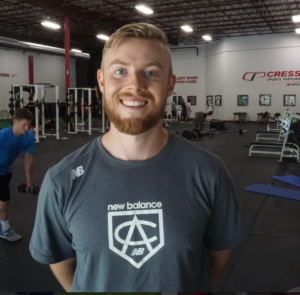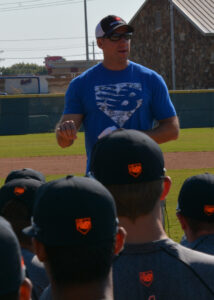
Should You Play Fall Baseball?
Today’s guest post comes from Cressey Sports Performance Director of Performance, John O’Neil.
We know that playing baseball year-round is a bad idea, but how do you determine if it’s a good idea for youth athletes to skip fall baseball and focus on developing themselves for the spring? Societal pressures – parents, coaches, scouts, recruiters – have dictated that if you’re a player and not doing as much total work as your competition is, you won’t keep up with the curve, but we know that’s not the case. Intelligent work will always trump total volume of work. The tough part lies in the action of identifying which athletes are better off sitting out a supplementary competitive season for the sake of success in the main season. Here are three questions to ask if you’re considering fall baseball and long-term baseball success is your goal:
1) How many innings did you throw during the spring and summer?
2) Are you playing another sport?
3) Are you adequately prepared for success within the fall season?
1) If you’re a pitcher and have thrown greater than 100 innings during the spring and summer seasons, fall baseball is highly contraindicated. A February 2011 study from Fleisig et al. provided the data for us that a youth pitcher, ages 9-14, is 3.5 times more likely to need an elbow or shoulder surgery down the road if they throw more than 100 innings in a calendar year. We can theorize and maybe think that a high school pitcher can afford slightly more innings, or, we could ask the question, what does a high school pitcher really gain out of throwing more than that? If they haven’t attracted recruiting attention in their first 100, you’re either not good enough to pitch at the next level OR have a very poor strategy for exposure. As CSP-FL co-founder Brian Kaplan has often said:
The goal should never be to “get seen;” the goal should be to create something worth seeing!
— Brian Kaplan (@BrianKaplanCSP) December 29, 2014
I’m in favor of shutting down pitchers at 100 innings, and I will provide more detail about when 100IP might not be the ideal number in point 3.
2) If you’re currently playing another sport, how does playing baseball as a secondary sport impact your long-term development? What is the goal of fall baseball? If the goal is skill acquisition and repeated exposure in a game environment, how does your commitment to the other sport detract or enhance from playing baseball?
Let’s take the high school soccer or football schedule. Most teams will have some type of organized activity six days per week, leaving one day a week where baseball can be the priority. From a skill standpoint, I would consider it more detrimental to both swing and throwing mechanics to be doing those in a fatigued state. Moreover, not providing the athlete with a true off day for the duration of the fall will lead to a much greater likelihood of an injury in the primary fall sport they’re playing. For position players, how much baseball skill work do you expect to get in only playing on weekends? A typical game might only involve a dozen swings and a handful of plays in the field, and that includes pre-game warm-ups.
If you’re not going to take a day off, maybe work on qualities in the gym that will ensure more long-term success. If you have the time given the constraints of the other sport, get to the cage/field multiple times per week if you feel the need to get more reps at the plate or in the field. Early specialization is not the answer for youth athletes. From a physical preparation standpoint, we know that specific physical preparation (SPP) is only as good as the general physical preparation (GPP) that underlies it. Even if baseball is the long-term primary goal, allow kids to develop GPP through other sports and specialize at the latest possible moment.
3) If fall ball is productive, what are the reasons? There are several: repeated game exposure can ensure success on a baseball field from a perspective of tension and arousal, as we can’t simulate those in the cage.
However, if the competitive season is already close to six months long, when does the athlete have time to develop other athletic skills that will carry over to success within the competitive season? Fall ball may be a time where you gain exposure to scouts/recruiters, or great for the northeast athlete who only played 30 games in spring/summer. But, if you can’t set the athlete up for success in the short fall season, why bother? Specifically, how much skill work can the athlete get in to be set up for productive game play?
For pitchers, this means getting in multiple throwing sessions per week outside of competitive throwing days within the fall season. It also means that the pitcher needs to have been ramped up and be ready to throw in game situations in the weeks prior to the season, making it tricky when the gap between summer and fall baseball is anywhere from 2-6 weeks. For every week off of throwing, I’d like to see pitchers ramp up for at least an equal, if not a double amount of time prior to getting back out there (one week off = 1-2 weeks ramping, 2 = 2-4, etc.). It doesn’t matter if you’re only throwing a few innings every Sunday. Be prepared to be successful every time you toe the rubber. This is a case where even if the pitcher only threw 50-80 innings – far short of the 100 recommended in point 1 – it’s not a good idea to throw them into the fire if they can’t play catch, long toss, and throw bullpens during the week.
If you fall into the three categories I outlined above, I’d advise against playing fall baseball and instead working on physical qualities that will ensure success from a more long-term perspective. Get to the gym, get stronger, faster, more athletic, work on durability, take time off from throwing, and prepare yourself for a successful spring and summer season.
Who Definitely SHOULD Play Fall Baseball?
If you do not fall into the categories above, you may still be asking if playing fall baseball is right for you. There are two categories of high school players who need to be playing fall baseball if they expect to move on and play at the collegiate level. As outlined above, even these players need to prepare for the fall season as if it were their main competitive season. In other words, they need to be sure they are throwing, taking BP, and training regularly even if only playing on weekends.
1) High School Seniors who don’t yet have a collegiate commitment
2) Players who didn’t play much during the spring/summer seasons
1) If you have a chance to be recruited to play in college, but haven’t yet received the right opportunity for any multitude of reasons, fall baseball can be a last-ditch effort to get in front of coaches and scouts. Many Ivy League and D2/D3 schools recruit well into the fall. Make sure you are picking the right spots, though. Get out to showcases/tournaments/camps where these coaches will actually be in attendance, given that it is your last chance to play in front of them. This will require far more advanced than (definitely) the spring and (usually) the summer season will. You can’t just play in any local weekend fall ball league and expect coaches to come find you if they haven’t already. For senior pitchers, you can be a little more aggressive with your workload during this time because the summer after senior year of high school will most likely be a low workload or complete dead period. For underclassmen, stick more stringently to the guidelines given above.
2) If you are a player that missed significant time during your main competitive season, regardless of grade, fall baseball is a very good idea. This could be in the case of someone who was injured and had to sit out, or, someone who was buried on the bench and only got half the amount of action as some of his teammates. In this case, keeping up with what everyone else is doing in terms of yearly workload is a very important thing. This will make you better on a physical level, as repeated exposure to better pitching and facing better hitters will have carryover to the main competitive seasons. Additionally, your comfort level in a competitive game experience could make or break your ability to play at the varsity high school level in the spring, or your ability to be good enough to get recruited in the summer that follows. Identify the biggest areas of need that will drive your ability to be successful long-term and address them. If you haven’t played in real games very much, this could be the limiting factor.
As you can see, the decision on whether or not to play fall baseball is a very individual one. Be sure to consider all these factors as you make that decision.
About the Author
John O’Neil (@ONeilStrength) is Director of Performance at Cressey Sports Performance-MA. You can contact him by email at joh.oneil@gmail.com and follow him on Instagram.






